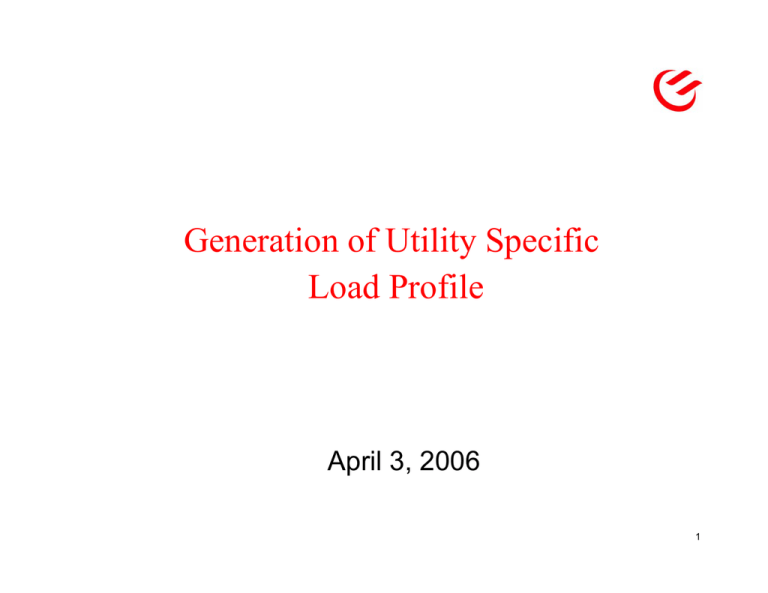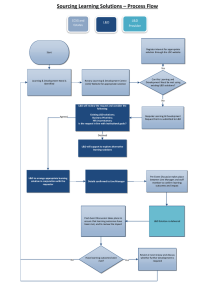General Guidelines - Ontario Energy Board
advertisement

Generation of Utility Specific Load Profile April 3, 2006 1 Generic Load Profile • Province-wide group formed to do joint load research work and received Board approval in November 2003 • Original membership includes about half of all LDCs, representing more than 80% of all electricity customers in the province • End product will be quality generic load shapes that meet OEB requirements for rate submission • Recently, additional 24 LDCs have joined the group wanting to share the generic load profiles • If you have not heard about this arrangement and would like to use the generic load profiles, please send contact information to LoadResearch@HydroOne.com 2 What is Generic Load Profile • Generic load profiles cover residential and general service customers for use in cost allocation analysis. Unmetered scattered loads will also be analysed • Residential load profiles include end-use profiles by electric space heating, electric water heating and air conditioning • General service customer load profiles include profiles by selected industry segment • Generic load profiles will be available in May 2006 • Please note the above generic load profiles need to be transformed into load profiles specific to your LDC 3 LDC Specific Load Profiles: Options • With respect to LDC-specific load profiles, individual LDCs have at least 3 choices: – do the LDC specific load profile analysis yourself, – hire an expert to prepare the analysis, or – request Hydro One to prepare the analysis • Hydro One plans to start this load profile analysis work for LDCs in May 2006 • Detailed information requirements and Hydro One contract will be finalized in April • LDCs will be providing information to Hydro One starting May 2006 4 Method Used to Generate LDC Load Profiles Weather normalization for total LDC load • Take out abnormal weather effects from the actual load so that kWh used for test year is weathercorrected • Hydro One weather normalization methodology will be used • Use latest 4 years of data to establish the statistical relationships between load and weather • Use 31 years of typical weather factors to derive the weather normal conditions 5 Method Used to Generate LDC Load Profiles Weather normalization by rate class • Residential heating and cooling loads are estimated using generic load shapes from the joint load research project and specific appliance saturation survey results or estimates for the LDC • General service heating and cooling loads are estimated using generic load shapes from the joint load research project (or available load shapes from Hydro One for load shapes not covered by the joint project) • Weather-corrected kWh by rate class will be used to generate LDC load profiles by rate class 6 Method Used to Generate LDC Load Profiles Residential Load Profiles • Joint load research provides generic end-use load profiles for electric space heating, electric water heating and air conditioning • Residential appliance saturation survey results or estimates are required to generate LDC specific residential load profiles • If residential appliance survey is not undertaken, Hydro One will use available information to prepare the analysis (provincial survey results from Statistics Canada, previous Ontario Hydro appliance survey results, kWh analysis using monthly data from LDC) 7 Method Used to Generate LDC Load Profiles General Service > 50 kW customers • Joint load research provides generic load profiles by industry segment • Similar industry segment grouping of general service > 50 kW customers are required to generate LDC specific load profile for these customers • Because of different operating characteristics, additional analysis using kW and kWh information for some industry segments will be required 8 Method Used to Generate LDC Load Profiles Interval Meter Customers • Hourly load profiles are already available. However, grouping by industry segment are required for weather normalization Unmetered Scattered Load (USL) • Load profiles will be based on analysis of recent monitoring results undertaken by LDCs. • Detailed breakdowns by photo sensitive, non-photo sensitive, weather sensitive sensitive loads are required and non-weather 9 Method Used to Generate LDC Load Profiles General Service < 50 kW customers • This is the residual class; no analysis is required • However, checking will be done by industry segment to ensure the load profile is reasonable Special Rate Classes • LDC is required to provide hourly profiles and assumptions for these specific rate classes 10 Input to Cost Allocation Model • LDC specific load profiles provide hourly (8760) load shapes for each rate class • These hourly load profiles will form the basis to generate the 1 NCP, 4 NCP, 12 NCP or 1 CP, 4 CP or 12 CP as may be required in the cost allocation model Please send any questions to LoadResearch@HydroOne.com 11

